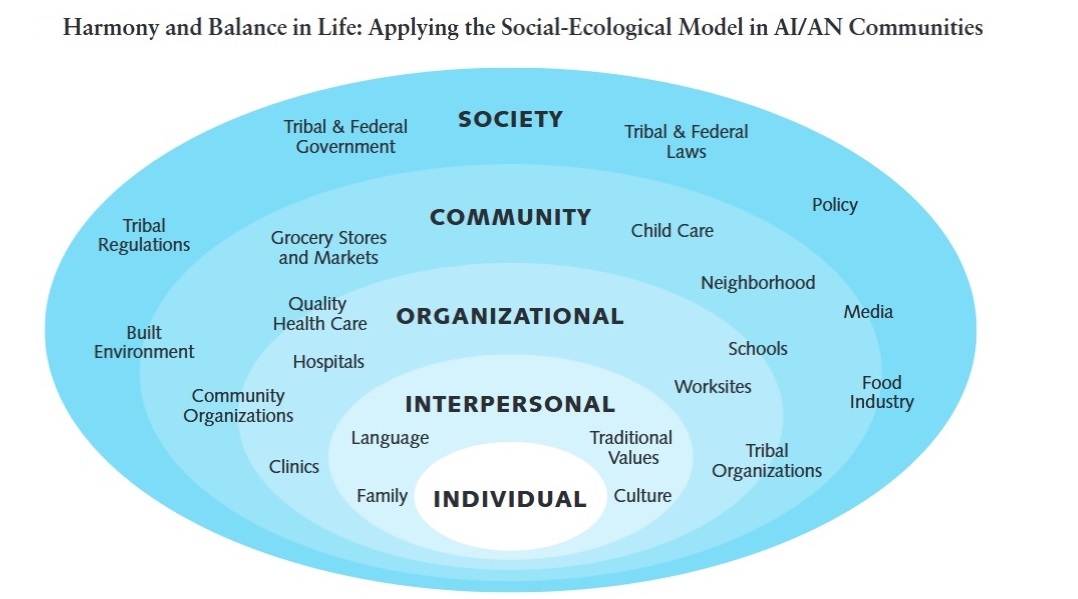Healthy Weight Model
The Indian Health Service, in collaboration with its partners, is determined to make a substantial and sustained effort to promote healthy weight across the lifespan in American Indian and Alaska Native communities. Given the multitude of factors that contribute to obesity and overweight, there is no one single approach that will work to turn the problem around. That is why individuals, families, schools, worksites, communities, the health care system, Tribal leaders and Tribal organizations, and society as a whole all have a role to play in achieving our vision for healthy weight across the lifespan.
The Social-Ecological Model, currently used by the public health community, provides a framework for addressing and influencing a person’s physical, social, and cultural surroundings to support long-term, healthy lifestyle choices for maintaining a healthy weight. As shown in Figure 1, the model, which encompasses all of the key sectors of society, is consistent with the value of connectedness of self, community, and place, intrinsic in American Indians and Alaska Natives as they strive for harmony and balance in life.
"Harmony and Balance in Life: Applying the Social-Ecological Model in AI/AN Communities," below, is a concentric 5-ring model. In the fifth and outermost ring is SOCIETY, Tribal and Federal Government ,Tribal and Federal Laws, Tribal Regulations, and Policy. Next, in the fourth ring, is COMMUNITY, including Grocery Stores and Markets, Neighborhood, Child Care, Community Organizations, and Built Environment. In the third ring is ORGANIZATIONAL, with Quality Health Care, Clinics, Hospitals, Worksites, Schools, Media, Food, Industry, and Tribal Organizations. The Second ring includes INTERPERSONAL, with Language, Family, Culture, Traditional, and Values. First and at the center is the INDIVIDUAL (Adapted from: Diabetes Care, November 2008, Vol. 31 (11), page 2217).

Society
This all-encompassing category involves communities, organizations, families, and individuals—all working together for change. Healthful nutrition and physical activity legislation, statewide school policies, media campaigns, and partnerships with Tribes are just some of the ways a comprehensive strategy to promote healthy weight across the lifespan takes shape on a large scale.
Communities
Community organizations include schools, worksites, the health care system, and Tribal organizations. These organizations can help individuals make better choices about healthful eating and physical activity by making changes in organizational policies and environments and by providing health information.
A community is like a large organization, able to make changes in policy and the environment to give its residents the best possible access to healthful foods and ways to be physically active. Changing zoning ordinances, improving parks, trails, walkways, and recreation facilities, creating ways to grow, gather, and hunt food, or distributing free or inexpensive fresh fruits and vegetables--these are some of the many ways individuals, groups, and organizations can work together to promote healthy weight.
For American Indians and Alaska Natives, this means:- Promoting community ownership and engagement.
- Increasing community self-empowerment.
- Engaging in community needs assessments.
- Providing communities with tools to help them change.
- Inviting full participation of Tribal leaders.
- Using the public health or population-based approach.
Individuals and Families
Close interpersonal groups, such as families and friends, are an important way to encourage more healthful behaviors and to give individuals the knowledge and support they need to make healthful eating and physical activity choices.
For American Indians and Alaska Natives, this means:
- Promoting self-empowerment and wellness.
- Strengthening the individual culturally, spiritually, physically, and emotionally (Life in Balance).
- Connecting individuals to intergenerational activities.
- Empowering elders to help facilitate change.
- Family mentoring to pass on healthy habits to children.
The best approach to promoting healthy weight is to develop a strategy that begins with conception of the fetus and includes interventions throughout the lifespan to promote lifelong healthful eating and regular physical activity.
Healthy Weight Across the Lifespan
The best approach to promoting healthy weight is to develop a strategy that begins with conception of the fetus and includes interventions throughout the lifespan to promote lifelong healthful eating and regular physical activity.
Fetuses and Newborns
- Promoting healthy weight at conception and during pregnancy
- Promoting diabetes (blood glucose) control before and during pregnancy
- Preventing low birth weight
- Preventing high birth weight
- Promoting breastfeeding (See Breastfeeding Promotion and Support to learn about the IHS Baby-Friendly Hospital Initiative and what health care providers can do.)
Infants and Toddlers
- Supporting breastfeeding (See Breastfeeding Promotion and Support.)
- Promoting timely introduction of healthy solid foods
- Decreasing sweetened beverage consumption
- Limiting fast food, takeout food, and eating out
- Encouraging 30 to 60 minutes of structured play and physical activity daily
- Decreasing TV viewing and other screen time
Children and Adolescents
- Promoting healthful eating habits
- Limiting fast food, takeout food, and eating out
- Promoting regular physical activity
- Limiting sweetened beverage consumption
- Decreasing TV viewing and other screen time
Adults and Elders
- Promoting healthful eating by modeling behaviors
- Decreasing portion size
- Limiting fast food, takeout food, and eating out
- Increasing physical activity
- Decreasing TV viewing and other screen time
- Promoting healthy weight maintenance
Protecting Children and Adolescents
Parents need to encourage children to follow the “5-2-1-0” model to ensure a healthy weight.
5. Eat 5 or more servings of fruits and vegetables each day.
2. Limit TV and other screen time to no more than 2 hours a day.
1. Engage in 1 hour of physical activity per day.
0. Limit sugar-sweetened beverages each day. None is best.


